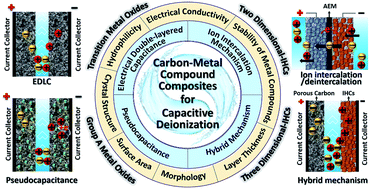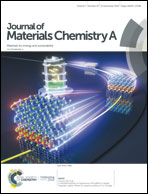Carbon–metal compound composite electrodes for capacitive deionization: synthesis, development and applications
Abstract
Capacitive deionization (CDI) is an emerging desalination technology that utilizes the capacitive properties (electrical double-layered capacitance, redox or ion intercalation pseudocapacitance) of electrodes to remove ions. A key challenge of CDI technology is the development of electrodes for the desalination of high concentration solutions at low energy levels. This requires electrodes to have a large desalination capacity, high charge efficiency and long-term stability. However, the development of pristine carbon materials has hit a bottleneck due to their structural properties (e.g., limited surface area) and adsorption mechanism (i.e., electrosorption). In contrast, metal compounds (especially transition metal compounds) have received increasing attention due to their dielectric property, redox activity or ion selectivity. This study comprehensively reviews the use of carbon–metal composites as electrodes for efficient CDI desalination, mainly with respect to their design strategies, synthesis, structural and electrochemical properties and desalination performance, and the roles that the metal compounds play in altering the structure and properties of their carbon composites. Some future directions, particularly pertaining to the use of simulation to accelerate CDI development, as well as the concerns of working with complex feed solutions, are put forward for attaining the goal of implementing CDI technology for seawater desalination.

- This article is part of the themed collection: Recent Review Articles


 Please wait while we load your content...
Please wait while we load your content...